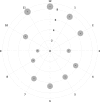Repeatability of quantitative measurements of retinal layers with SD-OCT and agreement between vertical and horizontal scan protocols in healthy eyes
- PMID: 31437222
- PMCID: PMC6705867
- DOI: 10.1371/journal.pone.0221466
Repeatability of quantitative measurements of retinal layers with SD-OCT and agreement between vertical and horizontal scan protocols in healthy eyes
Abstract
Purpose: To evaluate the repeatability of the new spectral domain optical coherence tomography (HOCT-1F), and also to evaluate the agreement between vertical and horizontal scan protocols. In addition, we also evaluated the relation between the repeatability and age.
Methods: Three consecutive measurements of the inner limiting membrane-retinal pigment epithelium (ILM-RPE), inner limiting membrane-inner plexiform layer (ILM-IPL) from macular horizontal and vertical scans, and inner limiting membrane-retinal nerve fiber layer (ILM-RNFL) from optic disc horizontal scan. 159 subjects were included in the analysis. The within subject standard deviation (Sw) and the repeatability limits (Rlimit) are used to represent the repeatability of the parameters for the different sectors.
Results: The Sw for the ILM-RPE thickness was less than 3.5 μm for each sector and scan direction. The Sw values varied within the sectors and scan modes, with horizontal scan modes resulting in better values for the horizontal sectors, and vice versa. The Sw for the GCL-IPL thickness was less than 2 μm, and was similar between the vertical and horizontal scan modes for each sector map. For the optic disc scan, the Sw was not symmetric along the clock-hour map sectors, the largest Sw values were seen in the vertical sectors (8.6 μm). The mean difference between the vertical and horizontal scans was less than 2 μm for each retinal thickness sector map. Significant but weak correlation between the Sw and the subject's age was seen in both macular and optic disc scans.
Conclusions: The repeatability of the HOCT-1F to measure the ILM-RPE-, ILM-IPL- and ILM-RNFL-thickness is good. The repeatability of the ILM-RPE thickness is dependent on the scan direction, which should be taken into account when calculating retinal thickness. There is a weak correlation between the repeatability and the subject's age.
Conflict of interest statement
The authors have declared that no competing interests exist.
Figures





References
-
- Wintergerst MWM, Schultz T, Birtel J, Schuster AK, Pfeiffer N, Schmitz-Valckenberg S, et al. Algorithms for the Automated Analysis of Age-Related Macular Degeneration Biomarkers on Optical Coherence Tomography: A Systematic Review. Transl Vis Sci Technol. United States; 2017;6: 10 10.1167/tvst.6.4.10 - DOI - PMC - PubMed
MeSH terms
LinkOut - more resources
Full Text Sources

